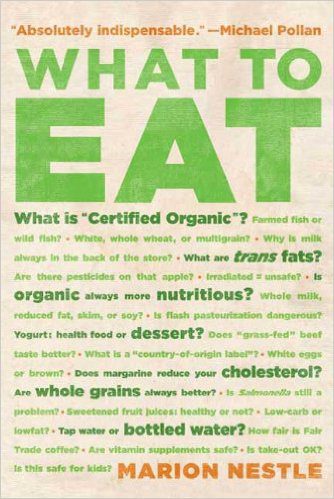What to Eat
by Marion Nestle
Book Description
Marion Nestle’s What to Eat has become the definitive guide to making healthy and informed choices about food. It is an indispensable resource, packed with important information and useful advice. How we choose which foods to eat is growing more complicated by the day, and the straightforward, practical approach of What to Eat has been praised as welcome relief. As Nestle takes us through each supermarket section—produce, dairy, meat, fish—she explains the issues, cutting through foodie jargon and complicated nutrition labels, and debunking the misleading health claims made by big food companies. With Nestle as our guide, we are shown how to make wise food choices–and are inspired to eat sensibly and nutritiously.
Now in paperback, What to Eat is already a classic—“the perfect guidebook to help navigate through the confusion of which foods are good for us” (USA Today).
Why I Like this Book
- Organized by supermarket sections: produce, dairy, dairy substitutes, the meat counter, fish counter, center aisles cool and frozen, center aisles processed foods and the beverage aisle, this is a deeply informative reference book that cuts through marketing myths to true facts about what we are really eating
- It is seriously dense and I have yet to read the whole book front to back. Instead, I refer to specific sections repeatedly. Of particular interest to me:
- The politics of organic produce is daunting; the key message I got was that organic production conserves natural resources, solves environmental problems and reduces the pollution of air, water and soil. Organic is better, but not necessarily for nutritional reasons.
- The section on fish raises the dilemma of eating fish for its health benefits when the impact of environmental toxins in fish directly impacts our health negatively, not to mention the dire overfishing that is emptying the oceans. But she offers a light in the darkness, if everyone who consumes fish asks for sustainable, healthy fish there is hope – both to keep fish in the ocean and to have the health benefits of fish
- It was very eye opening to read that we do not need as much dairy as we believe. As a matter of fact, dairy is part of the health problem, starting with the fact that dairy foods provide 15% of the total fat in the US food supply representing nearly 30% of the saturated fat, “the bad kind that raises the risk for heart disease.”
- Dairy and the calcium “myth”. It reinforces, in a very objective manner, the evidence that “in parts of the world where cow’s milk is not a staple of the diet, people often have less osteoporosis and few bone fractures than we do, they maintain calcium balance perfectly well on less than half the calcium intake recommended for Americans.”
- Every section provides relevant information to empower the reader in buying, cooking and eating food
- Although it wasn’t a surprise that food companies want to make money regardless if it affects consumers health negatively, the insight into what they do was eye-opening and makes me a better-informed consumer
About the Author
Marion Nestle is Paulette Goddard Professor in the Department of Nutrition, Food Studies, and Public Health at New York University, which she chaired from 1988-2003. She also holds appointments as Professor of Sociology at NYU and Visiting Professor of Nutritional Sciences at Cornell. Her degrees include a Ph.D. in molecular biology and an M.P.H. in public health nutrition, both from the University of California, Berkeley.
Her research examines scientific, economic, and social influences on food choice and obesity, with an emphasis on the role of food marketing. She is the author of three prize-winning books: Food Politics: How the Food Industry Influences Nutrition and Health (California Press, 2002, revised edition, 2007), Safe Food: The Politics of Food Safety (California Press, 2003, revised edition 2010), and What to Eat (North Point Press, 2006).
She writes the Food Matters column for the San Francisco Chronicle, and blogs daily (almost) at www.foodpolitics.com and for the Atlantic Food Channel at Atlantic Media-Food and Nutrition.



